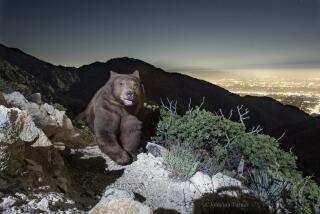Opinion: The ‘Man versus Bear’ TikTok meme went viral. Here’s another way to approach the question

If you’re alone in the forest, who would you rather run across: a man you don’t know or a bear? This question, posed to multiple women in a TikTok video last month, has taken the dilemma of man versus bear viral. And women online are nearly unanimous in favor of the stocky, shaggy, sleeps-through-the-winter one.
Let me clarify in case you know guys who fit that description: the bear. They’re all choosing the bear.
The question is a chance for women to compare fears, to figure out which danger looms larger. In the video that kicked off the trend, seven of the eight women who give “bear” responses lay out the same reasoning: A bear is appealing, they argue, precisely because it is not a man. “Men are scary,” one says.
Social networks such as Instagram, Facebook and LinkedIn can negatively affect women’s lives offline too.
Looking at the data, these responses are reasonable. The World Health Organization reports that nearly one-third of women worldwide have been subjected to physical and/or sexual violence, “mostly perpetrated by men.” (Statistics also tell us that a man you don’t know isn’t actually the greatest threat you might run across in the woods. It’s the man you do know — your intimate partner, in most cases — who poses the most danger.) Meanwhile, only a few people globally are hurt by bears in a given year.
Risk evaluation isn’t the only way to approach this question, though. Which creature women fear more is obvious, yes. But what about which one we want more? Is anyone passionately going for the bear?
It’s not unprecedented to consider, as people have chosen the company of predators before. More than 30,000 years ago, hunter-gatherers began to domesticate wolves. They picked a large carnivore to be their partner in the hunt, guard at home and loyal companion in general. In the millennia since, we’ve only gone further. People swim with sharks, keep boa constrictors in tanks in their living rooms and post selfies taken with tigers on their Tinder profiles.
A string of failures and heartbreaks gave way to the second chances I needed.
Women have pursued dangerous animals for the same reasons they’ve built relationships with men. For entertainment, for friendship, for support. For love. For … more? A woman entering into an affair with a bear is a wild thought, but one supported by tales of human-animal connections told throughout history.
You likely grew up hearing bedtime stories of women romantically entangled with creatures. Greek myths such as Leda and the swan and Europa and the bull; fairy tales such as “Beauty and the Beast” and “The Frog Prince.” Indeed, there are so many tales that fit the woman-animal-romance description that folklorists group them in the category “Animal as Bridegroom.” More recently, you might have seen the Oscar-winning film “The Shape of Water,” in which a woman falls for an amphibian, or read Rachel Ingalls’ novella “Mrs. Caliban,” about the exact same thing but published 35 years before the movie came out.
The women in these stories choose their beasts ecstatically, desirously, because picking the animal means getting to leave society behind. Frequently in this kind of story, the women are trapped by domestic drudgery. If they’re partnered, they’re housewives and stay-at-home moms, tasked with endless chores; if they’re single, they’re lonely librarians or debt-saddled graduate students, stuck at their desks. Their worlds are man-made, consisting of cake mixes and emotional labor. They’re not afraid of men — they’re tired of living in a patriarchy.
Gail Abarbanel’s lifework has been helping rape victims — and changing mindsets.
So they decide to get away from the world of men entirely. They go for the bear. Perhaps the finest, and most shocking, example in this animal-as-bridegroom category is the 1976 novel “Bear” by the Canadian author Marian Engel. Toward the end of her main character’s torrid affair with this animal, Engel writes: “[F]or one sharp, strange moment she could feel in her pores and the taste of her own mouth that she knew what the world was for. She felt not that she was at last human, but that she was at last clean. Clean and simple and proud.”
Certainly you should not walk in the footsteps of these fictional women, but you’ve got to consider their point. There’s a world out there, if only in fiction, where women have found an existence that’s cleaner, simpler, more free. Bizarrely, it comes with an animal lover, but what can I say? Myths and fairy tales are strange.
The stories we tell each other about beauties and beasts offer a reframing of the question of man versus bear. Instead of comparing one fear against the other, we weigh our desires. In your life, will you choose the lesser evil or the greater thrill? Think of the TikTok question this way: If you’re alone in the forest, are you focused on getting out, or would you like to see what’s possible when you venture deeper in?
Julia Phillips is a Guggenheim fellow and bestselling author. Her forthcoming book “Bear” will be published June 25.
More to Read
A cure for the common opinion
Get thought-provoking perspectives with our weekly newsletter.
You may occasionally receive promotional content from the Los Angeles Times.









